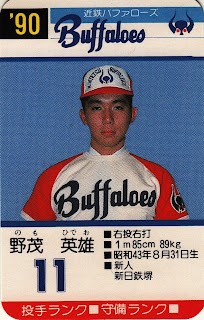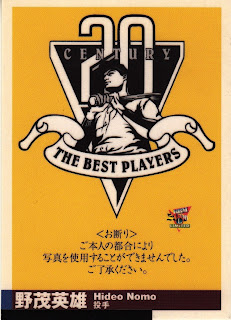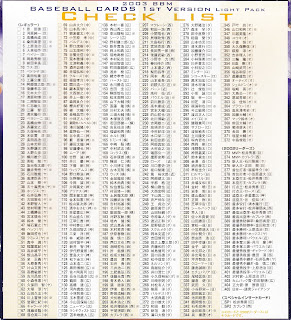Someone asked me about one of the cards in 1979 TCMA set in a
comment the other day and it made me think about the fact that I've been meaning to a post about that set ever since I started this blog. So, here it is:
TCMA was a card company from upstate New York that existed from the early 1970's to the late 1980's. The company name was formed from the initials of the two guys who started the company (Tom Collier and Mike Aronstein) although Aronstein bought Collier out very early in the company's history. There was a decision made at some point however that TCMA would stand for The Card Memorabilia Associates.
TCMA is mostly known for three things - the minor league sets they did from the mid-1970's up to around 1985, the "collector" sets they would do for old teams and players and the challenge they made to Topps' monopoly in 1975 with a set marketed under the company name "SSPC". But in 1979, they did a 90 card set for "Japanese Pro Baseball".
This set was marketed in the US in the same hobby publications that you could order other TCMA products. It was never marketed in Japan (and has no Japanese printing on any of the cards) - I've been told by a couple of the "pioneers" of the Japanese baseball card collecting hobby that this is actually a great set to take to Japan to sell since the card stores over there don't see it very often. Like the other TCMA sets it was only sold as a complete set, not as individual cards.
Player selection in the set is a little odd. There are 15 Hall Of Famers in the set - Kaoru Betto (Whales manager), Isao Harimoto, Tatsuro Hirooka (Swallows manager), Sachio Kinugasa, Takeshi Koba (Carp manager), Shigeo Nagashima (Giants manager), Katsuya Nomura, Sadaharu Oh, Katsuo Ohsugi, Keishi Suzuki, Morimichi Takagi, Tsutomu Wakamatsu, Koji Yamamoto, Kazuhiro Yamuchi (Orions manager) and Wally Yonamine (Giants coach) and another 5 players who are in the Meikyukai but not the Hall Of Fame - Michiyo Arito, Masahiro Doi, Makoto Matsubara, Yasunori Ohshima and Isao Shibata. Other Japanese stars include Yutaka Enatsu, Senichi Hoshino, Masanori Murakami, Yasushi Tao, Koichi Tabuchi and Masayuki Kakefu. As you would expect for a set being sold only in the US, there is a large number of Westerners in the set - 27 in all, nearly a third of the set. This includes Leron and Leon Lee, Bobby Marcano, John Sipin, Gene Martin, Charlie Manuel, Carlos May and Felix Millan. It also includes Don Blasingame who was in his season as Tigers manager and Vernon Law who was a coach for the Lions from 1979 to 1981.
What's odd about the player selection is who's NOT in the set. The Hankyu Braves are only represented in the set by two gaijin (Marcano and Bernie Williams -
this Bernie Williams, not
that Bernie Williams) so there's no Hisashi Yamada or Yutaka Fukumoto. There's several other Hall Of Famers active at this time who aren't included - Osamu Higashio, Manabu Kitabeppu, Tsuneo Horiuchi, Choji Murata as well as Buffaloes manager Yukio Nishimoto.
I noticed something else a little odd about the set - the Whales had moved from Kawasaki to Yokohama before the previous season, changing their name from the Taiyo Whales to the Yokohama Taiyo Whales. Three of the ten cards in the set for the Whales however (Makoto Matsubara, Masayuki Nakatsuka and Daisuke Yamashita) show their players in the Taiyo Whale uniform, not the Yokohama uniform - it's pretty obvious because the Taiyo uniforms were green and gold and the Yokohama uniforms were blue and white. So there's a couple pictures used in the set that were a couple years old at the time.
![]() |
| #7 Yamashita (left), #52 Millan (right) |
Odd though it may be, it's still a really cool little set. 1979 was the first year that Seibu owned the Lions and they brought in Tabuchi and Nomura for veteran leadership. It's interesting to see those two in Lions uniforms rather than the Tigers and Hawks uniforms that they wore for most of the previous seasons. The photography is all posed shots and some of the photos are quite good. Here's some more sample cards:
![]() |
| #76 |
![]() |
| #1 |
![]() |
| #9 |
![]() |
| #80 |
![]() |
| #17 |
![]() |
| #68 |
![]() |
| #12 |
![]() |
| #20 |
This and the 1987 "Play Ball" set are probably the easiest and least expensive pre-BBM sets to get. I think I've seen complete sets going for less than $50 on Ebay (although I have to admit that I don't pay a lot of attention to it anymore since I have one :-))
Some of the information about TCMA's history (other than my own recollections - I actually had bought this set in 1979 when I was in high school but sold it with the rest of my card collection when I was in college) came from
this interview with Mike Aronstein.
You know, if I remember correctly, there was an MLB All Star tour of Japan following the 1979 season that was televised back in the US on HBO - games probably weren't live but with the lack of internet or ESPN it would have been hard to find the results of the games anywhere before they were televised. I remember sitting in front of the TV with this set in hand, watching the games and figuring out who players were. At the time, I didn't know who anyone was other than Oh and Murakami and some of the gaijin.






















































